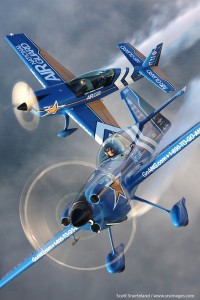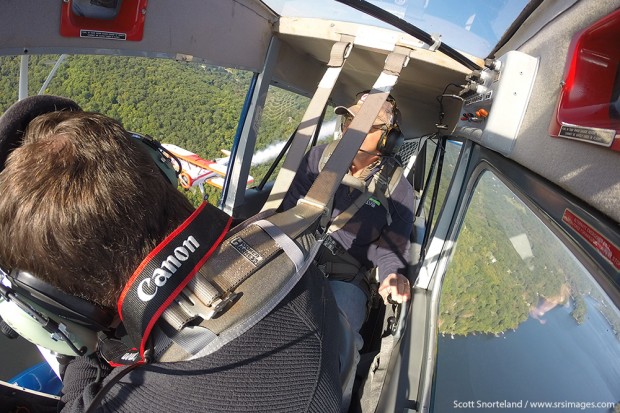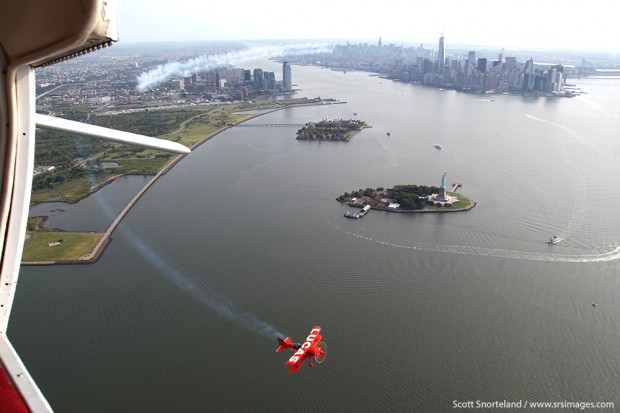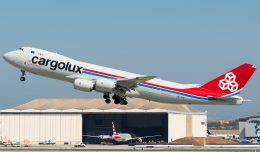(Editor’s note: Recently, NYCA sat down with our airshows correspondent, Scott Snorteland. As an accomplished air-to-air photographer, we wanted to know how he got into such a specialized segment of aviation photography. We also wanted to know what some of the challenges are that he faces in order to pull off a successful shoot. Airborne photography, especially of other airplanes in flight, is neither easy nor inexpensive. But when properly executed, the results can be incredibly fulfilling for both the photographer and their audience.)
 What piqued your interest in aviation and photography?
What piqued your interest in aviation and photography?
Both my father and grandfather were always into aviation. My grandfather was an aircraft mechanic in the south pacific during WWII so I think that’s what started it. I can remember looking through aircraft books as a child and had many of the planes memorized. The best was when my family would take trips out to Eastern Long Island where my dad would bring me to Calverton to watch Tomcats land and depart. In the mid 80’s, my dad and I went to a lot of airshows in the area with my Uncle Ross, my dad’s college roommate and his son. Military aircraft excited me as I had dreams of becoming a pilot in the Air Force when I grew older. Come the late 80’s I hit puberty and between school, sports and friends I stopped going to airshows and my overall interest in aviation slowed down.
It wasn’t until 2003 that I went back to my first airshow since the 80’s. My Uncle Ross was diagnosed with cancer and he would often come visit when he went to Sloane Kettering for treatment. In the winter of 2002 we saw an ad online for an airshow father’s day weekend at Stewart ANG base the next year. We decided that we would all go to the show just like old times. Unfortunately Ross passed away in early 2003. As the show date approached my father and I decided to follow through and go together anyway.
How did you get your start as an aviation photographer?
I was always into photography but it started as just a way to capture a moment with family and friends. I brought my film SLR to several shows from 2003-2005 but really got into it when I switched over to digital in 2006. That year I had taken a photo of aerobatic performer Matt Chapman at an airshow in Delaware that I posted on an aviation website. Matt saw the photo and contacted me in an effort to use it for marketing. During our discussion he offered to bring me down to Pennsylvania for the day and hire me to do an air to air shoot that would generate some photos for his sponsor Embry-Riddle Aeronautical University. Having never done any air to air photography I consulted a few friends in the industry, skilled photographers that had experience shooting air to air. After talking with them I accepted the job based on confidence in my ability to produce what was being asked.
When I got to the airport there was a piper Cherokee waiting for me with the door off, the seats out and a harness to keep me in the plane. I would be lying if I told you that I didn’t have second thoughts about going up at the time, but I trusted Matt as a person and his skills as a pilot. We departed N58 and in a matter of minutes Matt had formed up with us over the water. The sunlight was perfect on a beautiful evening and the sight of his plane flying next to us while I captured the images was something I fell in love with.
What type of camera/special equipment do you need for air-to-air photography?
I shoot Canon. For shooting aircraft from the ground it’s always good to have a telephoto lens, but in terms of air to air photography there is no real special equipment you need. Some people like to use a gyro when shooting slower rotating propeller aircraft in order to get a good disc blur however if you can shoot low shutter speeds and have a steady hand, they are not always necessary.
What are the challenges with shooting moving aircraft? Are there challenges specific to air-to-air photography?
There are several challenges to shooting aircraft. The main challenge for me when it comes to shooting air to air photography is finding both a suitable aircraft to take photos from as well as finding a competent and reliable pilot to fly that plane. I am not a pilot nor do I have a consistent aircraft I am able to use as my photo ship so usually this is where the majority of the work goes into.
There is a lot that goes into choosing a photo ship. Matching speeds is important, meaning having a photo ship that will fly as fast or as slow as the aircraft I’m taking photos of. I prefer not shoot through any glass either so this also means finding an aircraft we can pull the door off or even a window. Of course this is not always possible but it’s most preferred for obtaining the highest quality images.
Are you also a pilot? Are you responsible for knowing regulations surrounding air-to-air photography/formation flying or do you count on the pilot(s) to know that?
I don’t fly myself however I have been very fortunate to work with many talented pilots that have taught and showed me a great deal. In addition to finding the right photo plane, finding a good pilot to fly that plane is even more important. I have a few consistent pilots I can count on who I am comfortable with to fly for me. Other times I will use a close friend of the pilot I am shooting.
Safety always comes first and I stress this very much. I have a scripted brief that I discuss and go over with all involved on the ground before we even get inside an airplane. We discuss shots that we are looking to obtain and aircraft positions that we need to keep in order to do so. We talk backdrops, finding an area that is both picturesque and free of other traffic.
We discuss communication as well. The pilot’s main job is to fly the plane steady and level. The pilot also needs to know where the subject plane is at all times. If I’m shooting out of the starboard door I will keep the plane on that side always. I can communicate to my pilot always via headset. This is a must. I will communicate with the pilot of the plane I am photographing directly as well or have my pilot relay the messages. If there is not wired communication between myself and the subject I will use hand signals to place the aircraft where I want it for the shots we want. I rely on both my pilots as well as myself to maintain safety when it comes to formation flying. Closer isn’t necessarily better as I will often keep subject aircraft a few planes lengths away for both safety and framing. I encourage all involved to call out anything they don’t like and plan where both my aircraft and the photo subject will break should we need to quickly.
What should a beginner aerial photographer know about shooting aerial photos?
Safety! It’s not something you can just jump into without the right mentors, either experienced pilots and or aerial photographers. There are very few air to air photographers in general, so advice is scarce. I have learned a lot and continue to learn about safety and formation flying from experienced pilots. With that I have a saying: If it’s not safe to fly, it’s not safe to shoot. No photo is worth taking a chance – ever.
If someone wanted to, how would they go about getting into air-to-air photography as a career?
There are only a select few people out there who are strictly aviation photographers and they’ve been at it for years. Those who do shoot a lot of air to air photography are first photographers and shoot a lot of other work as well. I am strictly a freelance aviation photojournalist. I work in pediatric medicine as my career and do aviation freelance photojournalism on the side. There has been a lot of debate about freelance aviation work since I started; whether it takes away from the full timers or undermines them, and the bottom line is I love what I do and am happy to have had a chance to do it. Sometimes I think that I love it even more because I don’t do it for a living. When you have to do something it often becomes rote and repetitious.
Do you have any favorite stories to share about your experience shooting airplanes?
You can brief for hours to get a certain shot but sometimes a perfect shot just happens. I think that’s my favorite aspect of doing this is knowing you’re always going to capture something unexpected. When the light hits the plane just right, or when you fly over a cloud or something else cool that gives the photo that unplanned story.
What’s the best thing about air-to-air photography? The most difficult?
The best thing about shooting planes in the air is getting that photo that makes you say, wow! Landing and seeing that photo in the LCD of your camera is one of the best feelings. It tells the story of the very rare sight seen by a select few you just helped capture via an image. However for every one of those photos there’s 10 other shoots that will fall through for a variety of reasons and this can be the most difficult part. Whether it’s not having a photo plane, not having a qualified pilot, bad weather, high winds, bad light, mechanical issues, etc. It can be very frustrating. I’ve watched weather for hours, driven 2-3 hours to be met with a mechanical problem or unexpected clouds that just moved in. I know people doing aviation photography for 30 plus years who are still chasing down certain planes to shoot in the air. Once you accept that there are things you have no control over it becomes more enjoyable. I’ve often said, What the heck am I doing? I just wasted a day chasing an airplane. It doesn’t make sense at the time but I often come to do it all over again another day. That’s how I know I really enjoy it.
To see more of Scott’s incredible air-to-air photography, check out his previous articles recapping 2014’s Jones Beach Airshow, Rhode Island Air National Guard Open House, and our preview of the Greenwood Lake Airshow.









